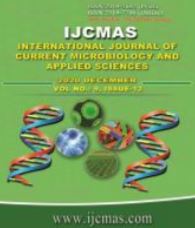


 National Academy of Agricultural Sciences (NAAS)
National Academy of Agricultural Sciences (NAAS)

|
PRINT ISSN : 2319-7692
Online ISSN : 2319-7706 Issues : 12 per year Publisher : Excellent Publishers Email : editorijcmas@gmail.com / submit@ijcmas.com Editor-in-chief: Dr.M.Prakash Index Copernicus ICV 2018: 95.39 NAAS RATING 2020: 5.38 |
Sclerotium rolfsii Sacc. is an destructive soil borne fungal pathogen with wide host range that includes groundnut, an important oil seed crop in India. Biological control offers an interesting alternative to fungicides for sustainable management of soil borne diseases. A total of ten isolates of actinomycetes were collected from different districts of Telangana and tested for their inhibitory activity against Sclerotium rolfsii Sacc., the stem rot of pathogen. These isolates were identified as Streptomyces spp. on the basis of standard bacteriological test and 16S RNA gene sequence analysis. Among the various isolates tested in vitro, three isolates (RGP-49%, NDG- 47.7%, YLD-45% inhibition) were found effective in inhibiting the mycelial growth of Sclerotium rolfsii in dual culture assay. These three potential isolates had shown 100% compatibility with the systemic fungicides (carbendazim, tebuconazole, propiconazole and azoxystrobin) whereas less compatibility with the non-systemic fungicides (captan and mancozeb) when tested by disc diffusion method. Seeds of groundnut when treated with Streptomyces spp. increased root length, shoot length and seedling vigour. Greenhouse studies revealed that talc-based formulations of Streptomyces spp. increased the germination percentage by RGP- 89%, NDG- 85%, YLD-84%. Among the three potential isolates maximum disease control was obtained when seed treatment and soil application of isolate RGP (Streptomyces parvulus) and YLD (Streptomyces werraensis) was used in controlling stem rot under greenhouse conditions.
 |
 |
 |
 |
 |